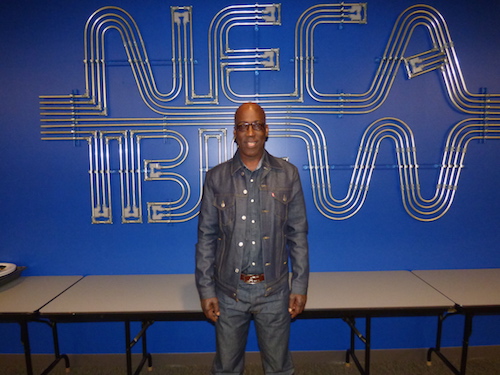Stories. They pour out when you retire from a job after 26 years.
Even before Rickey Brame Sr. hung up his inside journeyman wireman’s tools two years ago, the Portland, Ore., Local 48 member’s musings often turned to rich stories spanning the journey he and other African-American electricians have navigated through their local union.
Collecting tales, not just the sagas already known, but also the whispers of the electrical trade, came naturally for a guy who hung around his father’s popular barber shop. But Brame knew he couldn’t collect all the stories on his own.
So he and some co-workers asked his local union and NECA for help. In January, their labor-management committee produced a detailed history entitled, A Rising Tide of Diversity in the Oregon-Columbia Chapter of NECA and IBEW Local 48 Since World War II.”
 |
| “You have to know where you’re coming from to know where you’re going,” says retired inside journeyman wireman Rickey Brame Sr., who proposed Local 48 document the history of its minority members.. |
“I knew bits and pieces of our history, but not all of it,” says Brame, who pondered the legacy of electricians like Mark Smith. Smith, who came to Portland with an advanced college degree in response to the nation’s call for shipyard volunteers, joined Local 48 and worked as a journeyman marine electrician. Smith served as administrator of the Fair Employment Practices Division in the 1950s and 1960s where he brought racial discrimination lawsuits as administrator of the Civil Rights Division of the Oregon Bureau of Labor, all the while maintaining his license and membership in IBEW Local 48.
Brame knew that Smith was an exception. As the war ended, hundreds of other black shipyard workers, including his father, who had migrated north from Arkansas, were laid off. Local unions were reluctant to recruit them. Six of 14 labor unions even refused admission to African-Americans. Local 48 was the only union to admit black workers on an equal basis. But race relations on the job were still rough, mentors were too scarce and many black workers didn’t apply.
“You have to know where you’re coming from to know where you’re going. We still have a long way to go in Local 48 and the IBEW to build one big, strong, diverse union,”says Brame.
“I asked myself, first, why are there still so few second-generation black members in the local? And then I asked why can I walk through the hallways of Local 48 and not see faces of some of the leading minority men and women, the heroes like Mark Smith who made it possible for others to succeed,” says Brame. His request to Local 48 Business Manager Gary Young asking for help uncovering history and put it on display was timely.
The local and the National Electrical Contractors Association had just commissioned an elaborate history exhibit to coincide with Local 48’s 100-year anniversary in 2013, hiring a local freelance writer and historian, Alan Guggenheim, to research the local’s roots. The exhibit is on display at the NECA/IBEW Electrical Training Center.
Young took Brame’s proposal to NECA and Guggenheim was put back on the research trail. In January, he released a 52-page pamphlet, full of oral histories and newspaper accounts of minority workers overcoming obstacles and winning support for justice on the job.
After his co-workers read about the challenges minority workers faced, says Brame, “I’m getting reactions from both black and white workers like, ‘Are you serious?”
 |
| Photo used under a Creative Commons license from Flickr user cursedthing. |
Women, for instance, were everywhere in the shipyards during World War II. But they were expected to return to lower-paying jobs or homemaking after the war. “A Rising Tide” tells stories of courage and persistence personified by workers like Mary Gleason, a shipyard electrician who turned out of her apprenticeship at age 47 and became the first female electrician in the nation to collect full benefits under the IBEW pension plan in 1962.
Well-known contractors are chronicled including, Hugh D. “Buzzy” Allison, president of Oregon Electric Group; Reid Grasle Jr., president of what today is Dynalectri; and NECA manager Robert P. Burns, who with Local 48 and their joint apprenticeship program, formed a minority recruitment partnership with the Urban League of Portland that continues to this day.
The history includes members like retired Ninth District International Representative and former Local 48 Business Manager Keith Edwards, the first African-American elected to lead an IBEW inside electrician local.
Guggenheim says Edwards and many of the electricians he interviewed credited white union members and contractors who sought to build more inclusive apprenticeship programs, during the turbulent era of the 1960s and early 1970s, and continuing today. They include NECA contractors Bob Agee and Gary Price and business managers Ed Barnes, Herman Teeple and Clif Davis, now an IBEW International representative for business development. And the account celebrates the unsung heroes. Folks like Sam Whitney.
A member since May 1943, Whitney was the first African-American in Local 48 to earn his journeyman wireman’s card in the postwar era. He is remembered for his ramrod-straight military bearing and always wearing a coat and tie to union meetings. He encouraged and trained minority apprentices, and was the inspiration for a support group that included most of the local’s black electricians in the 1960s and early 1970s.
Upon his retirement in 1971, his successors, Brame included, continued meeting as the “Sam G. Whitney Association.” The group became the nucleus for what is now the local chapter of the Electrical Workers Minority Caucus.
Brame, who remembers attending rallies during the Civil Rights Movement with his mother, says he didn’t see “conduits for people of color into the building trades.” So he attended the University of Oregon and went to work as a salesman. He changed careers after a few friends who had entered apprenticeships showed him their paychecks.
“I’ve volunteered to be an ambassador for Local 48. I want to visit predominantly black high schools with story boards showing our history,” says Brame, who has worked as a foreman and general foreman.
Brame still counsels young members to attend union meetings, stay involved, save their money during the hard times and keep learning new skills. “I tell them they can’t just go to work and go home and ignore their local union. “They owe it to the folks [like those featured in “A Rising Tide”] to keep their legacy alive,” he says.
“Local 48 and Alan Guggenheim did an excellent job on ‘Rising Tide,’ says Keith Edwards, president of the national Electrical Workers Minority Caucus. “I see their efforts as a work in progress. There’s still more history to capture. We need to tell the whole story of minorities in the IBEW.” Edwards says he hopes other local unions will replicate Local 48’s work and the NJATC will incorporate the history of minorities in the union in its curriculum.
For Brame, the memories keep coming. Painful recollections are balanced by the pride he felt working on an all black crew building the city’s light rail line or seeing black electricians like Jean-wildy Malary, who advanced from residential electrician, find success as contractors.
Brame stays busy in retirement. He now owns the popular barbershop his father established and worked in until he died at age 86. He sharpens barbering tools for some extra cash, plays golf, volunteers at his church and spoils his nine grandchildren. “They’re my whole life,” he says. And Brame wonders what kind of world his grandchildren will inherit.
He looks around the community where he grew up and still resides. He still gets together with his old neighborhood friends, black, white and Asian to reminisce and catch up. Most of them have moved away. The neighborhood has been gentrified. High rises have replaced single-family homes. “It hurts me that I never see Local 48 electricians building them,” says Brame.
“Local 48 needs to get bigger and get more work. We can’t get there without being even more open to everyone who wants to come in,” he says.